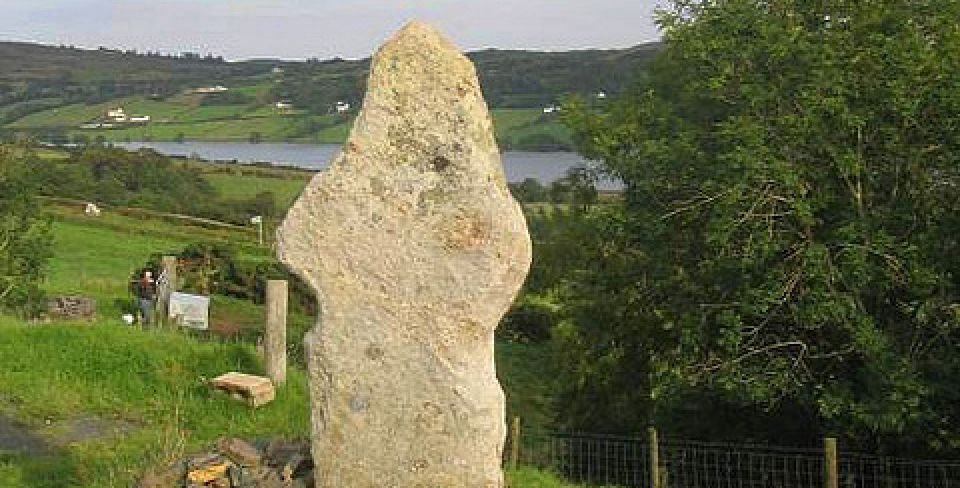3.3 Churchtown
Churchtown – Ráth Cnó – is said to be the place where Colmcille’s family lived. According to tradition they later gave over the land so that a monastic settlement could be created here.
The site is still used as a turas by pilgrims who walk barefoot between the five marked stations. Believers follow the turas between Colmcille’s feast day on 9th June and the end of the turas season on 15th August, performing a series of prayers and actions at each stop.
Churchtown was one stop on a longer medieval pilgrimage route which linked a number sites in the Gartan area associated with the early life of Colmcille.
It is said that this abbey was built by Manus O’Donnell in the 16th century. O’Donnell’s ‘Life of St Colum Cille’ was completed in 1532 and is the main source for the links between Colmcille and the Gartan area.
The centre of the graveyard is said to incorporate the foundations of a monastery.

This stone cross is one of two surviving on this site. Originally four crosses would have marked the boundaries of the monastic settlement here.
The area marked by the crosses offered protection to people who had been accused of committing a crime – they could be looked after in safety within the monastery’s land until such time as a trial could take place. So the monastery offered protection from arbitrary punishment.
Gartan – County Donegal
- 3.1 Colmcille Heritage Centre
The Colmcille Heritage Centre sits on the shore of Gartan Lough on the edge of Glenveagh National Park. Displays in the centre tell the story of Colmcille’s early years in the Gartan area and describe the spread of early Christianity in Ireland and Scotland, giving details of monastic and religious life. There...
- 3.2 Leac na Cumhaidh
This flagstone at Lacknacoo is one of the places where Colmcille’s mother Eithne is said to have given birth to him. The other place is at nearby Churchtown. The flagstone is dotted with small ‘cupmarks’. The origins of this ancient monument aren’t known but it may date to the Bronze Age....
- 3.3 Churchtown
Churchtown - Ráth Cnó - is said to be the place where Colmcille’s family lived. According to tradition they later gave over the land so that a monastic settlement could be created here. The site is still used as a turas by pilgrims who walk barefoot between the five marked stations....
- 3.4 Doon Fort & Holy Well
Until the 16th century, the Rock of Doon was the inauguration site of the O’Donnell chieftains. There were two ceremonies - one civil ritual here and one religious ritual which took place at Kilmacrenan. It is likely that this was the site of a fort belonging to the O’Donnells. Manus O’Donnell...
- 3.5 Kilmacrenan
This is where Colmcille is said to have lived with his foster father Cruithneachán. There are two parts to the site - the left hand side is linked to Colmcille while the right side is the site of a 19th century Church of Ireland church. This site formed part of...
- 3.6 Tulach Dubhglaise
Temple Douglas was an ancient monastic site which used to stand on the old road out of Letterkenny, the main route for travellers passing through the area. Colmcille is said to have been baptised here as a Christian in 521 by his foster father Cruithneachán mac Ceallachán. It was common...










Bòrd na Gàidhlig
Great Glen House
Leachkin Road
Inverness
Scotland, IV3 8NW
(+44) 01463 225454
colmcille@gaidhlig.scot
Colmcille
Foras na Gaeilge, 2-6 Queen Street
Belfast
Northern Ireland
BT1 6ED
(+44) 028 9089 0970
colmcille@forasnagaeilge.ie
Colmcille
Foras na Gaeilge, An Chrannóg
Na Doirí Beaga
Gaoth Dobhair
Donegal, Ireland. F92 EYT3
(+353) 074 9560113
colmcille@forasnagaeilge.ie


